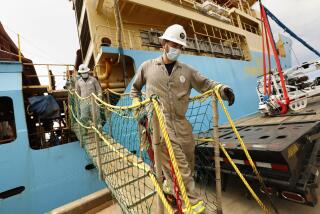Deep-Sea Corals Are Under Siege
- Share via
Most people would be surprised to learn that two-thirds of the world’s corals are not found in warm tropical waters but deep down in some of the ocean’s coldest, darkest places. Here, beyond the rays of the sun, lie spectacular coral gardens every bit as beautiful as their tropical counterparts and filled with living organisms that until recently were largely unknown.
Now, just as we are beginning to discover and explore these places, they are disappearing, victims of dredges and trawls that bulldoze the ocean floor in a relentless search for what lives on the bottom.
Found at depths of up to three miles below the surface, these deep-sea corals, which exhibit the same vivid hues as their tropical cousins, harbor a rich diversity of life, including sponges, sea anemones, shellfish and a host of other species critical to the marine food web. These coral formations form an essential part of the great under-story of the sea, providing shelter and spawning and breeding areas for fish and other creatures, as well as protection from strong currents and predators.
Although thousands of types of deep-sea corals have been identified, scientists estimate that thousands more may remain undiscovered, along with multitudes of other species that reside and depend on these complex habitats.
These places offer a wealth of knowledge for scientists and represent a potential treasure trove of natural substances that may prove useful in developing medicines, nutritional supplements, enzymes, natural pesticides, cosmetics and other products.
It is the great abundance of life in and around these deep-sea coral formations that attracts fishermen too, who have developed ever more sophisticated and powerful equipment able to reach depths of 6,500 feet, where it was once impossible to go. Heavy nets, pulled down by metal doors and chains that weigh tons, or which are attached to huge steel balls or rubber bobbins the size of airplane tires, are dragged along the ocean floor in search of fish, shrimp and crabs. In minutes, coral formations that took centuries to form and contain some of the richest marine ecosystems on Earth are smashed to pieces by the nets, which leave little more than a moonscape in their path.
Many marine scientists believe that bottom trawling causes more damage to the seabed than any other human activity. In the United States and in much of the world, fishing vessels using this destructive gear have strip-mined the ocean floor. Off the coast of Norway, it is estimated that one-third to one-half of all deep-water coral reefs have been damaged or destroyed. A 2002 study by the National Academy of Sciences found that in U.S. waters, trawling had damaged about 231,000 square miles of ocean bottom, an area greater than California. Off Florida, for example, where entire reefs of Oculina varicosa, a rare and beautiful species of ivory tree coral, once stretched along more than 100 miles of the continental shelf, only about 20 acres remain.
To protect what remains of the corals in U.S. waters, the federal government should immediately take the following steps: Identify and map U.S. waters that contain concentrations of deep-water corals and prohibit bottom trawling in these areas, establish and enforce severe penalties to prevent deliberate destruction of corals and modify or ban certain types of gear that are particularly destructive to the ocean floor.
It would be a pity if, only a few years after discovering these remarkable places, all that was left were broken shards on the ocean floor, evoking memories of a lost remnant of nature that once flourished but vanished before we were able to recognize, much less appreciate, its value.
Joshua Reichert directs the environment division of the Pew Charitable Trusts and is a director of Oceana, an international marine conservation group.





